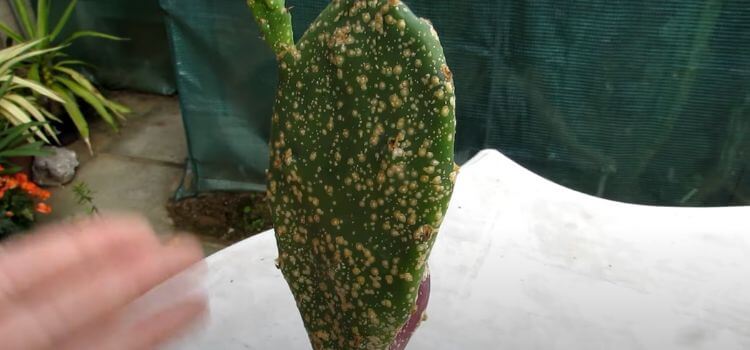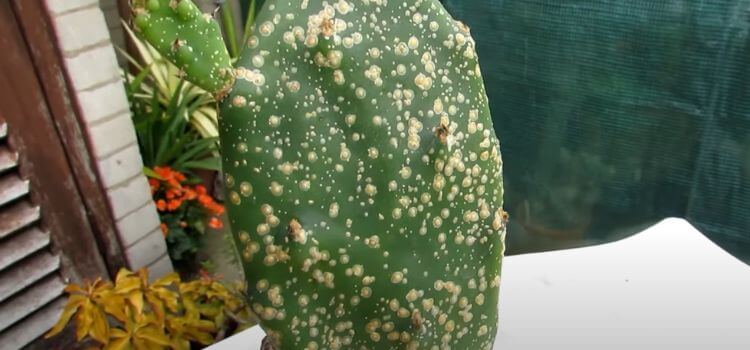As an Amazon Associate, I earn from qualifying purchases.
To remove scale insects on the cactus, apply neem oil or insecticidal soap directly to the affected areas. Ensure thorough coverage for effectiveness.
Battling scale insects on your beloved cactus can be daunting, but it’s crucial for the plant’s health and beauty. Scale insects, tiny pests that latch onto the surfaces of cacti, suck the sap from the plants, weakening them and potentially leading to death if not treated.
Recognizing the signs early is critical—look for small, bumpy protrusions on the cactus surface. These pests damage the cactus and can spread to other houseplants, making swift action necessary. Using neem oil or insecticidal soap as a treatment has proven effective. Both options are safe for the plant and the environment, targeting the pests without harming the cactus. Regular monitoring and prompt treatment can keep your cactus healthy and free from scale insects.
What are scale insects?
The Hemiptera scale insects feed on the juices of cactus stems and leaves. Small, oval, or round bodies in brown, whitish-grey, or purple are their identifiers. The two most common types of scale insects that infest cacti are soft scale and armoured scale.
Small, shell-like lumps on cacti’s undersides or spine bases indicate scale insect infestation. When pests eat, leaves are yellow, wilt, and fall off, and their honeydew attracts ants and promotes sooty mould.
Signs of Scale Insects on Your Cactus
- Look for tiny bumps on the cactus.
- The cactus might turn yellow.
- It might stop growing.
- Sticky stuff called honeydew can appear. This can lead to black mould.
Why are Scale Insects Harmful?
Scale insects are a type of pest that can really hurt trees and plants. They are small, sap-sucking insects that attach themselves to the stems, branches, and leaves of plants. These pests can vary in colour, from white or yellow to brown or black.
One reason why scale insects are considered harmful is because they feed on the plant’s sap. They harm and weaken the plant by injecting toxins into its tissue as they suck it. It can lead to stunted growth, wilted leaves, and even the death of the plant in severe infestations.
Can Scale Insects Kill Your Cactus?
Scale insects are tiny pests that can wreak havoc on your cactus plants. These minuscule insects feed on the sap of plants, which is essential for their survival. They feed on your cactus and leave honeydew, which attracts other bugs and enables fungal growth.
Scale insects can cause varying degrees of damage depending on the severity of the infestation. They can slow cactus growth, yellow it, or kill it.

How to Get Rid of Scale Insects on Cactus?
Keeping your cacti free of scale insects is crucial for their health and beauty. These tiny pests can cause severe damage if left unchecked. It’s always better to prevent an infestation than to fight one. Below are effective strategies to shield your cacti from these unwanted guests.
Cultural Practices
Healthy cacti are less likely to succumb to scale insect attacks. Use these cultural practices to keep your plants in top shape:
- Proper Watering: Overwatering can weaken cacti, making them more susceptible to pests. Ensure you water only when the soil is dry.
- Right Soil Mix: Cacti need well-draining soil. Mixing sand, perlite, and compost creates an ideal environment that prevents root rot and stress.
- Adequate Sunlight: These desert plants thrive in bright light. Place them where they can get at least six hours of sunlight daily.
- Nutrition: Fertilize sparingly. Excessive feeding can promote soft, sappy growth that attracts scale insects.
Remember, a stressed cactus is an open invitation to pests. Regularly check for signs of stress, such as discoloration, soft spots, or wilting. Addressing these signs early can prevent future infestations.
Quarantine And Inspection
When introducing new plants to your collection, preventing scale insects from spreading is vital. Follow these steps:
- Quarantine: Keep any new cacti separate from your collection for at least three weeks. Watch for any signs of pests or diseases.
- Inspection: Examine the new plants thoroughly. Look under leaves and near the base. Use a magnifying glass for a closer look.
- Clean Up: Remove any debris from the plant’s surface. Debris can hide scale insects or provide a place for them to lay eggs.
- Treatment: If you spot scale insects, treat the plant immediately. Use insecticidal soap or neem oil before introducing the plant to your collection.
Regular inspection of your cacti is also essential. Check your plants every week for any unusual signs. Early detection of scale insects can prevent a full-blown infestation. Use a soft brush or cotton swab dipped in alcohol to remove any scales you find. Be gentle to avoid harming the cactus.
Natural Remedies For Scale Insect Control
Scale insects can turn cacti into their feeding grounds, draining the plants’ vital juices and weakening their health. These tiny pests cling to cacti, often unnoticed until damage becomes visible. Fortunately, natural remedies provide safe, effective control.
Introducing Natural Predators
Employing natural predators in your garden is a smart way to tackle scale insects. These beneficial creatures feed on scale insects, offering a natural balance to pest populations. Consider these allies:
- Ladybugs: These beetles are famous for their appetite for soft-bodied pests like aphids and scales.
- Lacewings: Their larvae, known as aphid lions, are voracious eaters of scale insects.
- Parasitic Wasps: Tiny but mighty, these insects lay eggs inside or on scale insects, providing natural control.
Attract these predators by planting a diverse garden. Flowers like daisies, and Alyssum invites them to stay.
Remember, by choosing natural options, you not only keep these beneficial bugs safe and active in your garden, but also contribute to a healthier environment.
Diy Herbal Sprays
When it comes to fighting scale insects, herbal sprays are a gentle yet effective solution. These sprays, free from harsh chemicals, act as a deterrent for pests. Here’s how you can make your own:
- Neem Oil: Mix two teaspoons of neem oil with a quart of water and a few drops of mild soap. This disrupts the life cycle of scale insects.
- Garlic Spray: Blend two garlic bulbs with a small amount of water, strain, and add to a quart of water with a teaspoon of mild soap.
- Chili Pepper Spray: Boil a couple of chopped chili peppers in water, let it cool, strain, and add a few drops of soap.
Apply these sprays in the cool morning or evening hours to avoid leaf burn. Always test a small area first to ensure your cactus tolerates the spray. Repeat treatments might be necessary for best results. Here’s a quick recipe card for your reference:
Ingredient | Amount | Instructions |
Neem Oil | 2 tsp | Mix withn water and soap |
Garlic | 2 bulbs | Blend, strain and mix |
Chilli peppers | 2 peppers | Boil, cool, strain and mix |
Regular use keeps your cacti safe from scale insects. These herbal sprays also protect other plants in your garden.
Chemical Treatments for Stubborn Scale Insects
Scale insects can be a real nuisance for cactus lovers. These pesky bugs cling to your plants, sucking the sap and weakening them. Fear not; chemical treatments offer a reliable way to eradicate these pests.
Insecticidal Soaps
Insecticidal soaps serve as a potent weapon against scale insects on cacti. These soaps work by breaking down the insects’ protective waxy coating, leading to dehydration and death. Here’s how to use them effectively:
- Choose a soap designed specifically for plant pests.
- Mix the soap with water as directed on the label.
- Apply the mixture directly onto the affected areas.
- Repeat the application every 4-7 days until the pests are gone.
It’s essential to test the soap on a small area first to ensure it doesn’t harm your cactus. Please wait 24 hours to check for damage before applying it all over the plant. Remember, these soaps are most effective when pests are present, so early detection is critical.
Horticultural Oils
Horticultural oils are another effective chemical treatment for scale insects. These oils smother the pests, disrupting their ability to breathe and feed. To use horticultural oils on your cactus, follow these steps:
- Opt for a lightweight, refined oil that’s safe for plants.
- Mix with water according to the product instructions.
- Spray the solution onto the cactus, covering all infested areas.
- Apply on a fantastic, overcast day to avoid leaf burn.
Just like with insecticidal soaps, you should always conduct a spot test to prevent potential damage to the plant. The effectiveness of horticultural oils depends on thorough coverage, so ensure no pests are missed.

Step-by-step Guide For Scale Insect Removal
If your beloved cacti are under attack by scale insects, there’s no need to panic! This comprehensive step-by-step guide is here to reassure you and show you how to remove these pesky pests quickly and effectively. With the right approach, you can restore your cacti to their former glory.
Isolation Of Infested Plants
First, isolate the infested cactus. This step stops the scale insects from spreading to other plants. Follow these points for successful isolation:
- Move the infested cactus away from other plants.
- Check nearby plants for signs of scale insects.
- Keep the infested cactus in a separate area until it’s pest-free.
Next, inspect the cactus closely. Look for tiny bumps or cottony spots on the plant. These are telltale signs of scale insects. Use a magnifying glass if needed. Make sure to check:
Stay proactive and create a table to track the progress of your cactus’s recovery. Note down details like treatment dates and changes in the insect population. This active involvement helps you stay on top of the situation and ensures the best outcome for your cactus.
Thorough Cleaning And Treatment
After isolating your cactus, it’s time to clean and treat thoroughly. Begin by gently wiping down your cactus with a soft brush or cloth to remove any loose scale insects. Be gentle to avoid damaging the plant. Proceed with these steps:
Consider using natural predators like ladybugs to help control the pests. These friendly insects eat scale insects and can be a great help. Remember to keep your cactus in a well-ventilated area during treatment. Good airflow helps prevent mould and mildew, which can also harm your cactus.
Caring For Cactus After Scale Insect Treatment
After successfully treating your cactus for scale insects, the journey to recovery begins. Providing the proper care to ensure your cactus thrives and remains pest-free is vital. A healthy cactus can resist pests better than a weak one.
Monitoring For Reinfestation
Keeping an eye on your cactus is critical to preventing scale insects from returning. Start with regular checks of your plant. Look for tiny, shell-like bugs on the stems and underside of leaves. Use a magnifying glass if needed. Early detection makes all the difference. Here are some tips:
- Inspect weekly: Choose a day each week to examine your cactus closely.
- Check new growth: This is where scale insects often reappear.
- Look out for honeydew: A sticky substance that can indicate an infestation.
Keep a journal to note any changes or signs of pests. This will help you act fast if scale insects return. If you do find them, isolate the affected plant to protect others. Use insecticidal soap or neem oil as soon as possible to prevent spread.
Post-treatment Care
After treating scale insects, your cactus needs extra attention. This is to help it heal and grow strong. Here’s how you can care for your cactus after treatment:
- Water wisely: Overwatering can stress your cactus. Allow the soil to dry between waterings.
- Provide proper light: Ensure your cactus gets enough sunlight but only a little direct sun.
- Avoid fertilizers: Wait for your cactus to recover before using any fertilizers.
- Prune-damaged areas: Use sterile tools to remove any parts severely damaged by scale insects.
Keep your cactus in a well-ventilated area and avoid drastic temperature changes. Watch for new growth, as this is a good sign of recovery. Remember, patience is vital. Give your cactus time to bounce back to its full glory.
FAQ On How To Get Rid of Scale Insects on Cactus?
Most cactus plants have scales that look like fuzzy or moist bumps on their stems or pads. These bumps make up the insects’ protective skin. They can be brown, grey, yellow, or even orange and may look like part of the cactus at first glance. Regularly inspect your cactus for these unusual growths, which can damage the plant over time.
A cotton swab or soft brush bathed in rubbing alcohol removes apparent scale insects while minimizing the risk of damaging the cactus. Care should be taken to avoid damaging the cactus. Also, spraying the cactus with a solution of dish soap and water can help smother the insects. Always test a small part of the plant first, and do not apply in direct sunlight to minimize potential damage.
Yes, overwatering can deepen scale insect problems. Moisture attracts these insects, making overwatered cacti more susceptible to infestation. Be mindful of your watering schedule and adjust it as necessary, allowing the soil to dry out between waterings to help the plant recover.
Heavy-scale infestations can weaken your cactus, which can become apparent in its growth patterns. Look for slow growth, yellowing or drooping of the cactus’s spines, and a general decline in health. Act quickly to treat the infestation and help your cactus recover.
Conclusion
Cactus owners can struggle with scale insects, but with proactive steps and timely treatments, you can eliminate them. Always respond quickly at the first sign of an infestation and prioritize natural, cactus-friendly methods.
Scale insects require patience and persistence, but your efforts will provide healthy, thriving cacti for years.

